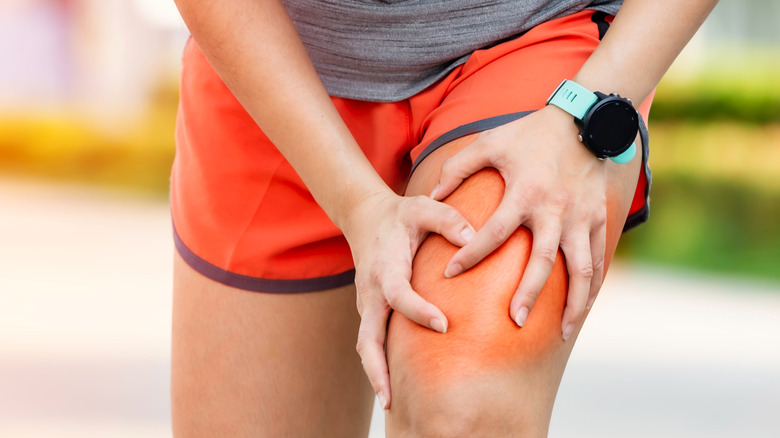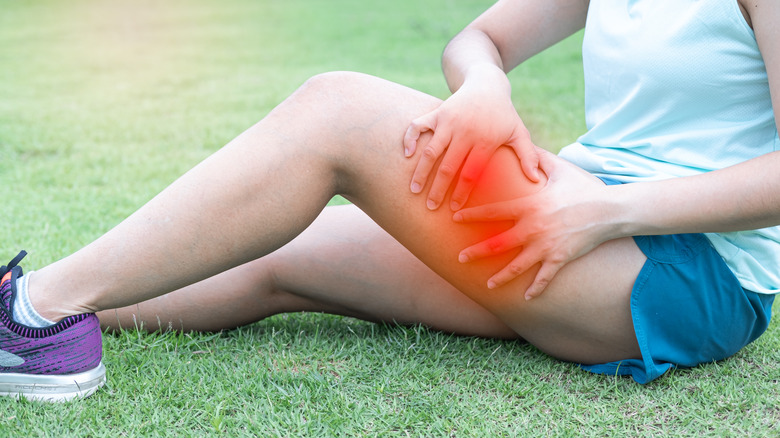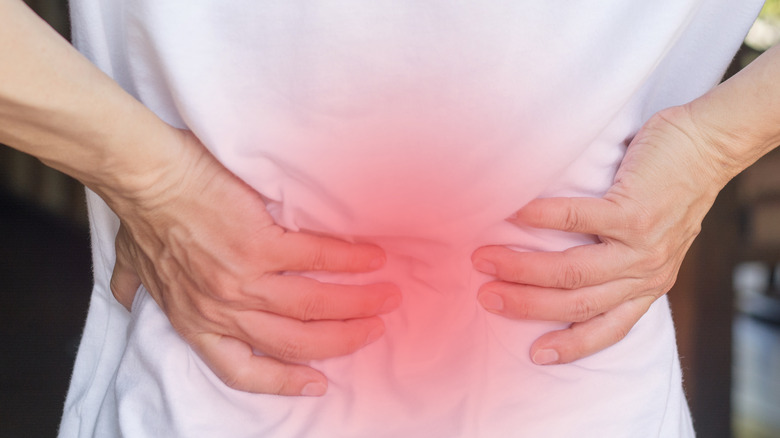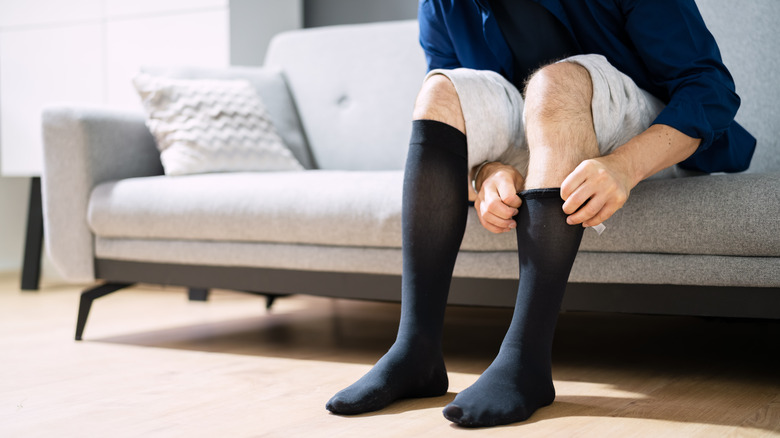What Your Thigh Pain Could Really Mean
Do you have ongoing thigh pain that prevents you from moving around or playing sports? This problem is relatively common, and its causes can range from poor circulation to musculoskeletal injuries. In rare cases, thigh pain may be due to deep vein thrombosis, nerve damage, or bone infections, explains Buoy Health. Sometimes, even small things like sitting for long periods or trying a new activity can cause pain in the thigh. For example, someone new to cycling, running, or horseback riding may experience this symptom for a couple of weeks until their body adapts to the activity in question.
The thighs are made up of several muscles, including the adductors, quads, hamstrings, sartorius, and pectineus, notes the Cleveland Clinic. These muscles have nerve fibers, blood vessels, and other anatomical structures. A good example is the sciatic nerve, which goes all the way from the lower back to the hips, glutes, hamstrings, calves, and feet. An injury to the sciatic nerve can cause pain in the thigh and leg, depending on the nerve root(s) involved, says Veritas Health.
Thigh pain may be accompanied by other symptoms, such as tingling and numbness, stiffness, or backaches. Sciatica, for instance, may also cause a tingling sensation, lower back pain, or muscle weakness. Take note of these symptoms over several days before reaching out to your doctor. The more specific you are, the better. With that in mind, here are some potential causes of thigh pain and what to do about it.
Muscle strain
A muscle strain — or pulled muscle — can cause pain, tenderness, bruising, and swelling in the affected area. Depending on its severity, it may limit your range of motion and make it difficult to carry out your daily tasks. This type of injury can affect any muscle or tendon, but it's more common in the hamstrings, explains the Mayo Clinic. In some cases, it may become chronic and lead to ongoing pain. If you only have a mild strain, you may be able to treat it at home.
Heavy lifting, repetitive motions, falls, and poor exercise technique are all common causes of muscle strains, according to the University of Pittsburgh Medical Center (UPMC). The risk of injury is higher in those who play high-impact or contact sports, but you could also pull a muscle while playing golf or tennis. Although there's no surefire way to prevent muscle strains, you can mitigate the risks by warming up before exercise.
The first thing you should do immediately after pulling a muscle is to rest the affected area and apply ice for 15 to 20 minutes at a time. Wrap your thigh with an elastic bandage to reduce the swelling, suggests the Mayo Clinic. Stack a couple of pillows on top of each other, and place them under your knees to keep your leg elevated at night. Rest for two or three days, see how you feel, and do some rehab work to regain your flexibility and range of motion, recommends UPMC.
Meralgia paresthetica, a common cause of thigh pain
Do you have a burning or tingling sensation on the outer side of your thigh? Perhaps you're also experiencing pain and numbness in that area. These are common symptoms of meralgia paresthetica, or Bernhardt-Roth syndrome, a condition affecting the lateral cutaneous nerve of the thigh. It typically occurs when the nerve becomes compressed due to localized trauma or other factors that promote swelling, according to Johns Hopkins Medicine. For example, repetitive motions can cause inflammation and compress the nerve, leading to a "pins and needles" sensation in the thigh. In some cases, meralgia paresthetica is due to excess body weight or tight clothing, both of which can put pressure on the nerve.
This condition isn't a medical emergency, but it can interfere with your daily life. You may experience more severe pain after walking or standing for longer periods, as well as other symptoms, such as sensitivity to touch. The symptoms may worsen or go away on their own, notes WebMD. Pregnant women and people with an underactive thyroid, diabetes, or leg length discrepancies are more likely to develop meralgia paresthetica.
Treatment depends on the root cause of your problem. If you only have mild symptoms, you may feel better after losing some weight or taking painkillers. Also, consider wearing loose-fitting pants rather than leggings or skinny jeans. Physical therapy, stretching, and strength work may help, too, says WebMD. With proper treatment, your symptoms should subside within four to six weeks.
Lumbar spinal stenosis
Aging, repetitive movements, and other factors may cause a narrowing of the spine. This condition is called spinal stenosis and can affect any region of the back, including the lumbar area, with thigh pain being one of the most common symptoms. You may also experience tingling, leg weaknesses, and mild to severe pain in the lower back, buttocks, or calves. The pain may worsen when you walk or stand and subside when sitting or leaning forward, explains the National Health Service (NHS).
The NHS estimates that about 75% of people over 40 have some degree of spinal stenosis. Its symptoms may remain unchanged or progress over the years, but they may also improve with adequate treatment. Regular exercise, medications, and physical therapy can all help. Surgery is only recommended in severe cases. For example, some people may develop cauda equine syndrome, a condition that occurs when certain nerves in the lumbar and sacral region become compressed. This process can lead to bladder or bowel incontinence and excruciating pain in one or both legs, reports Johns Hopkins Medicine. Cauda equine syndrome is a medical emergency that requires surgical intervention.
While it's not possible to prevent spinal stenosis, you can reduce the damage to your spine through lifestyle changes. Try to maintain a normal weight, stay physically active, and watch your posture, recommends Johns Hopkins Medicine. Those who already have this condition may benefit from massage therapy, stretching and strengthening exercises, or over-the-counter medicine, such as ibuprofen or amitriptyline.
Prolonged sitting
Sitting is considered the "new smoking" — and for good reason. This habit can affect your spine and posture, causing tight muscles, knee pain, and bulging discs, warns Dr. Elan Goldwaser, a sports medicine specialist at NewYork-Presbyterian. Over time, it may lead to sciatica and weak hip flexors, both of which cause pain in the thighs. In clinical trials, prolonged sitting has been linked to a higher risk of lower back pain, heart disease, and venous disorders, reports a 2015 review published in Rehabilitation Nursing.
When you sit for long periods, the nerves in your spine and legs become compressed, which may cause thigh pain. Sitting also decreases blood flow to your legs, creating tingling and numbness, explains Loma Linda University Health. What's more, this habit can raise blood pressure and affect your arteries, resulting in further damage to the nerves. These factors combined may lead to pain in the thighs, calves, neck, and back, among other problems.
Unfortunately, it's not always possible to avoid sitting, especially if you have an office job. The best thing you can do is stand up and take a short walk or stretch your muscles every hour or so. Some studies suggest that compression stockings may reduce leg pain and fatigue, but more research is needed in this area (via Rehabilitation Nursing). Alternatively, you could switch to a standing desk, use shoe inserts, or floor mats to diminish the discomfort associated with prolonged sitting.
Deep vein thrombosis
Another common cause of thigh pain is deep vein thrombosis (DVT), a condition that promotes the formation of blood clots inside the veins. Most people will also experience swelling and redness in the initial stages of the disease, according to Weill Cornell Medicine. If left unaddressed, DVT can lead to post-thrombotic syndrome or chronic venous disorders. There are cases where a blood clot can travel to the lungs and cause pulmonary embolism, a life-threatening condition.
DVT can have a multitude of causes, from old age and lack of exercise to injuries. Cigarette smoking, obesity, and certain medications, such as birth control pills, may contribute to this disorder, too, warns the Mayo Clinic. Sometimes, DVT may result from an underlying condition like cancer, inflammatory bowel disease, or heart failure, but it can also have genetic causes. Treatment usually consists of blood thinners, clot busters, or more invasive procedures, depending on the severity of your condition. You may also need to wear compression stockings, quit smoking, or lose extra weight.
As you can see, thigh pain can point to a number of issues ranging from overuse injuries to underlying diseases. Your healthcare provider is the only one who can make an accurate diagnosis. It's not uncommon to feel pain in the thighs following a more intense workout or prolonged sitting, but you should see a doctor if your symptoms last longer than a few days.






